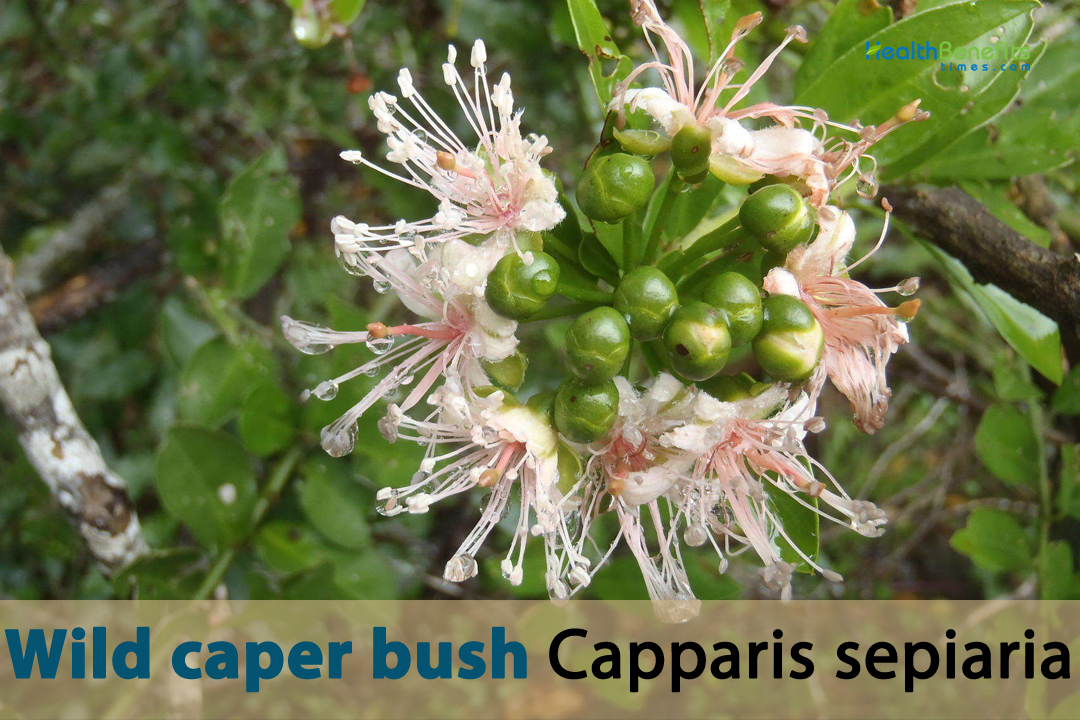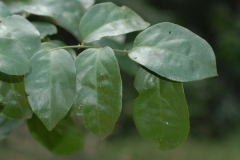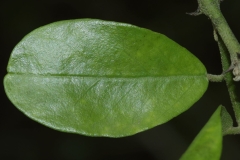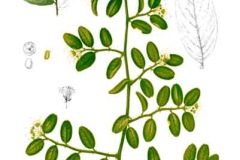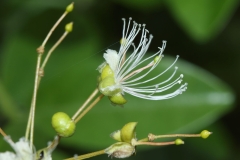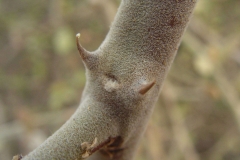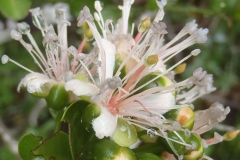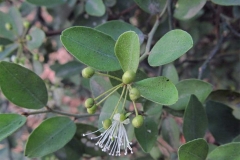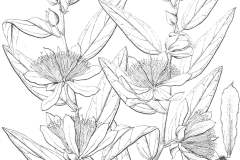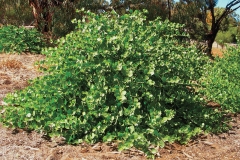| Wild caper bush Quick Facts | |
|---|---|
| Name: | Wild caper bush |
| Scientific Name: | Capparis sepiaria |
| Origin | India, China, Indian Subcontinent, Indo China, Malesia, northern Australia and tropical Africa |
| Colors | Start out green and become yellowish as they ripen |
| Shapes | Rounded, 8 to 10 millimeters in diameter |
| Taste | Bitter, Pungent |
| Major nutrients | • Vitamins • Minerals • Antioxidants • Dietary Fiber • Phytochemicals • Proteins • Phytosterols • Essential Fatty Acids • Carbohydrates • Amino Acids • Phosphorus • Carotenoids • Folate |
| Health benefits | Heart Health, Weight Management, Bone Health, Cancer Prevention, Liver Support, Skin Health, Blood Sugar Regulation, Allergy Relief, Wound Healing, Cancer Prevention |
| Name | Wild caper bush |
|---|---|
| Scientific Name | Capparis sepiaria |
| Native | Extremely widespread in India, China, Indian Subcontinent, Indo China, Malesia, northern Australia and tropical Africa, where it occurs from Senegal eastward to Eritrea and Ethiopia and southward to northern South Africa |
| Common Names | Caper bush, Common caper, Flinders rose, Wild caper plant, Caper berry, Caper bud, Caper flower, Caper shrub, Spiny caper bush, Rock caper, Common caper bush, Caper shrub, Caper plant, Caper vine, Caper thistle, Prickly caper, Spiny caper, Mediterranean caper, Caper spurge, Flinders caper |
| Name in Other Languages | Afrikaans: Wilde kapertak, Wild Kapertjies Albanian: Kalli i egër, Kapari i egër Arabic: Kabbār (كبّار), Kabir al-bari (كبر البري), Alkibar albariya (الكبار البرية) Armenian: Antarraghjutʿyan kʿapar (Անտառահաղջության քապար), Tsaghrank andam (Ծաղրանք անդամ) Assamese: Wild Caper, Jangli Keppor (জংলী কেপৰ) Azerbaijani: Yaban xəyar Basque: Baratza basati Bengali: Kyāpāra (ক্যাপার), Bonyo Caper (বন্য ক্যাপার), Banya Caper (বন্য ক্যাপার), Bon Caper (বন ক্যাপার), Jongoli kyapar (জঙ্গলী ক্যাপার), kaliakara, kaliyakara (কালিয়াকাড়া), kanta gurkamai (কাঁটা গুড়কামাই), kelekora (কেলেকোঁড়া) Bodo: Jangli Kapar (जंगली कपर) Bosnian: Divlji kapar Bulgarian: Div kapers (Див каперс) Catalan: Capers Salvatges Chinese: Yěshēng cìhuái (野生刺槐), Yěshēng cìshān gān (野生刺山柑), Qīngpí cì (青皮刺), Gong xu hua, Qu zhi chui guo teng, Qing pi ci Croatian: Divlji kapar Czech: Divoká kapara Danish: Vild kapersbusk, Vilde Kapers Dutch: Wilde kappertjesstruik English: Wild Caper Estonian: Mets-kapris Filipino: Mga bulaklak ng alcaparras, Ligayang bukid Finnish: Villi kaprispensas, Villikaprista French: Câpre sauvage German: Wilde Kapernpflanze Georgian: Bunebrivi kapari (ბუნებრივი კაპარი) Greek: Kapari (Κάπαρη), Agriokaparo (Αγριοκάπαρο), Ágria káppari (Άγρια κάππαρη) Gujarati: Jangli Caper (જંગલી કેપર), Vanaspati Caper (વનસ્પતિ કેપર), Vanmaracha (વનમરચા), Kanther, kanthar (થાર), kalo-kantharo (કાળોકંથારો) Hebrew: Tzanun Bar (צנון בר) Hindi: Kāpar paudhā (कापर पौधा), Jangalī kaipar (जंगली कैपर), Jangli Caper (जंगली कैपर), Kanta Harimili (कांटा हरिमिली), kanthari, Kantari, heens, hiun, kanthari (कंथारी) Hungarian: Vadkapri, Vad kapribokor Icelandic: Vill kafurtre Indonesian: Kapulaga liar Irish: Capall Faoi Italian: Cappero selvatico Japanese: Wairudokeipā (ワイルドケイパー), Yasei no keipā (野生のケイパー), Yasei kyappā (野生キャッパー) Kachchhi: Karo-kanthar (કારોકંથાર) Kannada: Kaadu Caper (ಕಾಡು ಕೇಪರ್), Vanaspati Caper (ವನಸ್ಪತಿ ಕೇಪರ್), kaadu kathari (ಕಾಡು ಕತ್ತರಿ), kattiri gida (ಕತ್ತಿರಿ ಗಿಡ), olle uppi gida (ಒಳ್ಳೆ ಉಪ್ಪಿ ಗಿಡ) Kashmiri: Jangli Caper (جنگلی کیپر) Konkani: Wild Caper, Van Caper (वन कॅपर) Korean: Waildeu keipeo (와일드 케이퍼), Waildeu keipeo deombul (와일드 케이퍼 덤불), Yasaeng Ppongnamu Yeolmae (야생 뽕나무 열매) Kurdish: Keparê wîldî Lithuanian: Laukinis kaparis Latvian: Meža kapara Macedonian: Diva kapar (Дива капар), Div kaper (Див капер) Malay: Pokok kaper liar, Hutan Caper, Kaper liar Malayalam: Vanakappari (വനക്കപ്പരി), Kaattu Caper (കാട്ടു കേപ്പർ), Vanaspati Caper (വനസ്പതി കേപ്പർ), Kaakkathhonbhi (കാക്കത്തൊണ്ടി), Kakkathondi, kaakkaaththonti (കാക്കത്തൊണ്ടി) Maori: Parera Manipuri: Wild Caper, Wakhoi Thoiding (ꯂꯤꯄꯥ ꯅꯝꯉꯤ) Marathi: Vanaspati Caper (वनस्पती कॅपर), Van Caper (वन कॅपर), Jangali kāpar (जंगली कॅपर), Kantharyel, Kantara, Maastodi, kanthar (कंथार), maastodi (मांसतोडी) Montenegrin: Divlji kapar Nepali: Jangali Kapar (जंगली कपर), junge laharo (जुँगे लहरो) Norwegian: Vill kaprisbusk, Vill kapersbusk, Ville Kapers Odia: Banya Caper (ବନ୍ୟ କେପର), Jangali Kapar (ଜଙ୍ଗଲି କପର), kakachincha (କାକଚିଞ୍ଚା), pirika (ପିରିକ) Persian: Gol kaper (گل کپر), Kapar-e vahshi (کپر وحشی) Polish: Dziki kapar, Dzikie kapary Portuguese: Capparis spinosa, Alcaparra selvagem Punjabi: Jangli Caper (ਜੰਗਲੀ ਕੈਪਰ) Romanian: Căpșună sălbatică, Capar sălbatic Russian: Kapers (Каперс), Dikiy kapers (Дикий каперс) Samoan: I’a I’a Sanskrit: Kanthari, Grdhranakhi, Ahimsra, Vyaghrayudha, ahimsra (अहिंस्र), dhvankshadani (ध्वाङ्क्षादनी), dhvankshadanti (ध्वाङ्क्षदन्ती), dhvankshanakhi (ध्वाङ्क्षनखी), durmoha (दुर्मोहा), grdhranakhi (गृध्रनखी), kakadani (काकादनी), kanthari (कंथारी), vakrashalya (वक्रशल्या), vayasadani (वायसादनी), vayasahva (वायसाह्वा) Santali: Jhade Kaper (ঝাড়ে কাপের) Scottish Gaelic: Gabhar Fiadhaich Serbian: Divlji kapar, Divi kaper (Диви капер) Sindhi: Wild Caper, Jangli Kepar (جنگلي ڪيپر) Sinhala: Wala kapar (වල් කැපර්) Slovak: Divoký kapar Slovenian: Divji kapar Spanish: Alcaparra, Alcaparrón Swahili: Mchicha wa mwitu, Mchicha wa porini, Simba porini Swedish: Vild kaprisbuske Tamil: Kaattu Caper (காட்டு கேபர்), Kaattu Milagu (காட்டு மிளகு), Kattukkathiri, Thoratti, Karunchurai, curia (சூரை), karu-n-curai (கருஞ்சுரை), kattu-k-kattari (காட்டுக்கத்தரி) Telugu: Atavi Caper (అటవీ కేపర్), Adavi Usirikaya (అడవి ఉసిరికాయ), nalla puyyi (నల్ల పుయ్యి), nalluppi (నల్లుప్పి) Thai: Khaeppoe phanthu pa (แคปเปอร์พันธุ์ป่า), P̄hum kạpexrp̂ p̀ā (พุ่มคะเปอร์ป่า), Krahai Pa (กระหายป่า), H̄nām wạw sạng (หนามวัวซัง) Turkish: Çıntar, Yabani kabarcık, Vahşi kapari çalısı Ukrainian: Dykyi kapers (Дикий каперс) Urdu: Jangli kaipar (جنگلی کیپر), Wild Caper (وائلڈ کیپر) Vietnamese: Cây cây cây dưa (Cây cây cây dưa) Welsh: Ceffylau Gwyllt Yoruba: Ewe Odidere Zulu: Ithangaza eliyinaturali, Inyamazane |
| Plant Growth Habit | Scrambling, prickly, evergreen, deciduous perennial shrub or small tree |
| Growing Climates | Often found in disturbed areas, rocky terrain, along roadsides, savannah, drier places in thickets, hedges, teak-forests, in lowlands, near seaside, open woodlands and scrublands |
| Soil | Does best in slightly acidic to neutral pH (around 7.0) sandy or rocky soils that drain well |
| Plant Size | 30 to 90 centimeters tall and 60 to 180 centimeters wide |
| Root | Cylindrical tapered roots |
| Leaf | Small, typically about 1 to 3 inches (2.5 to 7.5 centimeters) long and oval to oblong in shape |
| Flowering season | Between March and June |
| Flower | Flowers can be quite showy and are typically 1 to 2 inches (2.5 to 5 centimeters) in diameter. |
| Fruit Shape & Size | Fruit is rounded, 8 to 10 millimeters in diameter |
| Fruit Color | Start out green and become yellowish as they ripen |
| Seed | Small, typically measuring about 2-4 millimeters in length |
| Varieties |
|
| Flavor/Aroma | Earthy, herbal, and slightly pungent notes |
| Taste | Buds: Sharp, pungent, and slightly tangy Leaves: Less tangy and have a subtle herbal taste with a touch of bitterness Berries: Less pungent with a bit of sweetness |
| Plant Parts Used | Buds, roots, leaves and fruits |
| Propagation | By seeds, semi-hardwood cuttings and root division |
| Lifespan | Around 20 to 30 years, although some can live longer under ideal conditions |
| Season | August to September |
| Major Nutrition |
|
| Health Benefits |
|
| Available Forms |
|
Plant Description
Wild caper bush is a scrambling, prickly, evergreen or deciduous perennial shrub or small tree. It grows about 1 to 3 feet (30 to 90 centimetres) tall and 2 to 6 feet (60 to 180 centimetres) wide, but it can sometimes grow bigger in the right conditions. The plant grows in a thick, sometimes crooked way, with many branches coming out from the base. Depending on where it lives, it may also climb or walk along the ground. The plant is often found in disturbed areas, rocky terrain, along roadsides, in savannah, and in drier places like thickets, hedges, teak-forests, lowlands, near the sea, open woods, and scrublands. The plant does best in slightly acidic to neutral pH (around 7.0) sandy or rocky soils that drain well. Roots that get stuck in water need good drainage. Adding organic matter to the soil can help it grow more plants and drain better.
The plant is used to make food, medicine, and power in the area. It is sometimes grown in tropical Africa so that people can eat the leaves, which are sold in local stores. It has been used in Mediterranean cooking for hundreds of years and is a key ingredient in meals like chicken piccata, pasta puttanesca, and many salads. Their unique taste has made them a staple in the food practices of the area. Capers are important to the economies of some areas because they can be grown and picked for money. The caper business gives people in the area a way to make a living and helps the food industry trade with other countries. The plant is thought to be harmful to animals that eat it. The root is said to be deadly, and a poison made from the root flour is used to hunt.
Appropriate growing environment for Wild caper bush
Wild caper bushes are hardy plants that can tolerate a range of growing conditions but thrive in specific environments. To create an appropriate growing environment for wild caper bushes, consider the following factors:
- Climate: Caper bushes grow naturally in the Mediterranean, and they like a mild temperature. They can handle some cold, but they do best in places where summers are hot and dry and winters are mild and wet. They are not good for places that are very cold or very hot.
- Sunlight: For the best growth, caper bushes need to be in full sun. Make sure they get 6–8 hours of direct sunshine every day.
- Soil: Caper bushes do best in slightly alkaline to neutral pH (around 7.0) sandy or rocky soils that drain well. Roots that get stuck in water need good drainage. Adding organic matter to the soil can help it grow more plants and drain better.
- Watering: Once they are established, these plants can survive in dry conditions, but they need to be watered often while they are growing. Let the dirt dry out a little between watering to keep the roots from getting rotten. Once they are established, caper trees don’t need much care.
- Temperature: During the winter, protect young caper bushes from frost because they are more sensitive when they are young. Mature plants can handle short periods of cold weather, but they may need some shelter during harsh winters.
- Pruning: Caper bushes need to be pruned once a year to keep their shape and encourage new growth. Before new growth starts, prune in late winter or early spring.
- Fertilization: Caper bushes don’t need to be fed a lot of fertilizer. In the spring, you can give your plants the nutrients they need by using a balanced, slow-release fertilizer. Avoid too much nitrogen, which can make the plant grow too much foliage at the cost of making capers.
- Pests and Diseases: Pests and diseases don’t bother wild caper trees very much. Keep an eye out for aphids, mealy bugs, and caterpillars, though, because they can sometimes get into the plants. Use insecticidal soap or neem oil to take care of any problems right away.
- Support: Caper bushes usually grow as plants that spread out or as climbers. Giving them a trellis or other support structure can help them grow up and make it easier to pick the capers.
- Harvesting: Caper bushes usually grow as plants that spread out or as climbers. Giving them a trellis or other support structure can help them grow up and make it easier to pick the capers.
Roots
The roots of wild Caper Bush are usually made of fibers. This means that it has a lot of small, branching roots close to the surface of the dirt. These tiny roots help the plant get water and food from the soil quickly. It usually has short roots, which help it grow well in rocky or sandy soils, which are common in dry or semi-dry areas. Because its roots are short, it can get to water more easily.
The thick, fibrous roots help the plant survive dry times. They can quickly soak up water when it’s available and store it so they can use it later when it’s dry. In addition to being used in food and medicine, it is also prized for its ability to help keep the soil stable and stop it from washing away. Its dense root system helps hold the soil down, which helps with attempts to save soil.
Stems
Most of the time, the roots are woody and spread out. They can grow to be several feet long, and the small, sharp spines or thorns along the roots give them a thorny or prickly look. They grow like vines, with long, thin roots that can trail on the ground or climb on nearby buildings or other plants for support. One of the most noticeable things about the stem is that it has thorns or spines, which protect it from animals. These thorns can be sharp, so you have to be careful when you touch the plant.
Leaves
On the stems, the leaves are grouped in pairs. This means that each leaf is connected to the stem one at a time, and as they go up the stem, they switch sides. Most leaves are oval or lance-shaped. They are long and can be different sizes, but most of the time they are small to medium, about 2 to 4 inches (5 to 10 centimetres) long. Most of the time, the tips of the leaves are smooth and do not have serrations or teeth. The leaves look simple and smooth because of this. The white or pinkish flowers and caper buds on the plant stand out against the leaves, which are usually a bright, shiny green.
Like most plants with two sets of seeds, the leaves have a web of lines. These lines help water and food get to all parts of the leaf. Most of the time, the lines are not very noticeable and do not stand out on the leaves. The leaves are smooth, and the tops of them are shiny and a little bit waxy. This makes it harder for Wild Caper Bushes to lose water through evaporation in the dry places where they often grow. Each leaf has a small stalk, or petiole, that holds it to the stem. This lets the leaves move up and out of the way to get the most sunshine. The color of the leaves can change a little bit based on things like how old the plant is, how it grows, and how stressed it is. Most Wild Caper Bush trees, on the other hand, have the same green color. Leaves are very important to the process of photosynthesis, which is how plants get energy from the sun. They also stop the plant from losing too much water through transpiration and keep animals from eating it.
Flowers
Flowers are single, which means they grow on a plant by themselves instead of in groups called inflorescences. The flowers can be any color, but most of the time they are white or a light pink. The exact color can rely on many things, like how old the flower is. Flowers are usually about 1 to 2 inches (2.5 to 5 centimetres) in diameter. Their small size adds to how delicate they look. Most flowers have between four and six blooms. Most of the time, the petals are thin and delicate, making the flowers look fragile and papery. Sepals cover the base of the petals and protect the flower bud as it grows. Most sepals are green and can curl back or spread out.
The stamens, which are the male reproductive parts, are long and stand out inside the flower. The amount of stamens can vary, but usually there are a lot of them in a column in the middle. The pollen is made in the anthers, which are at the end of the stamens. The pistil, which is the female part of the plant, is in the middle of the flower. It has an ovary, a stigma, and a style. The stigma is where pollen sticks. The style links the stigma to the ovary, which is where the seeds are growing. Flowers often have a nice, slightly sweet smell that can draw in bees.
Most of the pollination of these flowers is done by insects, like bees and ants, which are drawn to the nectar and pollen that the flowers make. The flower’s structure, with its large petals and pistil, makes it easy for pollen to move from one flower to another. Depending on where it is and what the weather is like there, the Wild Caper Bush usually blooms in the spring and summer.
Fruits
A berry is the fruit. Berries are thick fruits that grow from a flower’s ovary. They usually have seeds inside. The shapes of most fruits are round or oval and small. Usually, they are about the size of a small pea or a little bigger, with a width of about 0.2 to 0.4 inches (5 to 10 millimeters). When the fruits are ready, they are green, but as they get older, they become more yellow. The skin of the fruit is thin and soft, and the inside is soft and juicy.
Even though most people don’t eat the fruit, the closed flower buds (capers) of the plant are very popular in cooking. Before these buds turn into fruits, they are pickled so they can be used as a tasty sauce.
Seeds
The seeds of wild capers are small and usually measure between 2 and 4 millimeters in length. They look like ovals or kidneys and feel hard and woody. Seeds can be any color, but most of the time they are dark brown to black. The seed coat is the part of the seed that is on the outside. The seed coat of wild caper seeds is very hard and durable. This protects the baby inside. It can be ridged or wrinkly, which makes it even stronger. The hilum is a small scar on the seed that shows where it connects to the nucleus of the fruit. This scar is usually noticeable on wild caper seeds and helps show which way the seed should face when it starts to grow.
Varieties of Wild caper bush
Wild caper or Indian caper is a species of flowering plant that belongs to the Capparaceae family. While it may not have as many recognized varieties or subspecies as the more well-known Capparis spinosa (common caper), there is some variability within Wild caper bush. Here are a few notable varieties or forms:
- Capparis sepiaria var. sepiaria: This is the most common type of wild caper plant and is called the “nominate” form. It is native to different parts of Asia, including India. It is a deciduous bush or small tree with compound leaves and flowers that are white to pale pink. The flower buds, which look like those of the Capparis spinosa, can be picked and used in food.
- Capparis sepiaria var. microphylla: The leaves of this type are smaller than those of a normal wild caper. It lives in dry and semi-dry places because it is used to hard conditions.
- Capparis sepiaria subsp. nummularia: The leaves of this type stand out because they are shaped like coins. It lives in some parts of India and has changed to fit the local climate.
- Capparis sepiaria var. brevispina: This type is known for having small, thick spines or thorns. It often grows in places that are rocky or dry, and it may have changed in order to survive in these harsh circumstances.
- Capparis sepiaria var. canescens: Due to the fine hairs on the leaves and stems, this variety may look more grey or silver, like the “canescens” type of Capparis spinosa. This change may help it hold on to water in dry places.
- Capparis sepiaria var. angustifolia: Wild caper bush leaves may be smaller in some places than they are in others. This difference could be caused by the local environment and selective forces.
- Capparis sepiaria subsp. nummularia: This type has leaves that are shaped like coins, which is different from how most wild caper leaves look.
- Capparis sepiaria var. incana: This type is known for having leaves and stems that look more downy or hairy, which is an adaptation for a certain ecological niche.
Health benefits of Wild caper
Wild capers offer a range of potential health benefits due to their nutritional composition and bioactive compounds. Here’s a detailed overview of these health benefits:
1. Rich in Antioxidants
Antioxidants like flavonoids (such as quercetin and kaempferol) and polyphenols are found in large amounts in wild capers. Antioxidants fight free radicals in the body, which lowers oxidative stress and keeps cells from getting hurt.
2. Anti-Inflammatory Properties
Capers can help reduce inflammation because they have quercetin and rutin in them. Regular use may help lower inflammation, which has been linked to a number of long-term illnesses.
3. Heart Health
There are several ways that wild capers can help your heart health. Because they relax blood vessels, they may help lower blood pressure, improve how well blood vessels work, and lower the risk of atherosclerosis. Capers also contain vitamins that can help lower LDL cholesterol.
4. Weight Management
Capers are low in calories and high in fiber, which can make you feel full and help you control your weight by keeping you from eating too much.
5. Digestive Health
The root of the wild caper bush has been used to help the body digest food for a long time. It might help get your body to make more digestive enzymes, which can make it easier to absorb nutrients and ease stomach pain.
6. Bone Health
Vitamin K, which is found in wild capers, is very important for bone health because it helps the body absorb calcium and makes bones stronger. Getting enough vitamin K might help your bones be stronger and less likely to break.
7. Cancer Prevention
Some studies show that quercetin and other chemicals in capers may be able to fight cancer. They can stop cancer cells from growing and lower the risk of some cancers, like bowel and breast cancer.
8. Liver Support
Wild capers have been used to help the liver work for a long time. They might help the liver get rid of toxins and stay healthy in general.
9. Skin Health
Because of their possible benefits, extracts from the caper bush have been used in skin care products. They might help protect the skin from damage caused by UV rays, reduce skin inflammation, and make the skin look healthy.
10. Blood Sugar Regulation
Quercetin in capers may help control blood sugar by making insulin work better, but more study is needed. This can be especially helpful for people who already have diabetes or are at risk of getting it.
11. Allergy Relief
By stabilizing mast cells, quercetin’s anti-allergic qualities may help ease allergy symptoms such as a runny nose, sneezing, and itchy eyes.
12. Improved Cognitive Function
Antioxidants in capers may prevent oxidative damage to brain cells, which could lead to better brain function and a lower chance of neurodegenerative diseases.
13. Anti-Microbial Properties
Some studies have shown that products from the wild caper bush can kill bacteria. Some bacterial and fungal diseases can be helped by these qualities.
14. Wound Healing
In traditional treatment, the leaves and roots of capers have been put on wounds to help them heal. Their possible anti-inflammatory and antibacterial effects could help people get better faster.
15. Cancer Prevention
Some of the compounds in the caper bush, like quercetin and kaempferol, have shown promise in lab tests as possible anti-cancer agents. They might help stop cancer cells from growing, but more study is needed to confirm these findings.
Culinary Uses of Wild caper
Wild caper is a plant whose flower buds and young fruits are often used in culinary applications. Here are some culinary uses of Wild caper
- Pickles: Wild caper flower buds are often pickled and used as a condiment in many different dishes. They taste like real capers, with a sour and slightly bitter taste. You can put these pickled buds on salads, sandwiches, or use them as a garnish for different meals.
- Flavoring: You can chop up the pickled buds or young fruits and use them as a tasty seasoning in meals like pasta, sauces, and Mediterranean-style foods. They give the dish a unique and spicy taste.
- Curries: Wild caper is used to make curries and other tasty foods in some Indian and Southeast Asian cuisines. Spices and other ingredients are cooked with the flower buds or young fruits to make the dish taste better.
- Chutneys: The pickled buds can be added to chutneys or sauces to give them a tangy and sour kick. You can eat these chutneys as snacks, with grilled meats, or as a side dish.
- Rice Dishes: Wild caper is used to flavor rice recipes in some parts of the world. During cooking, the pickled seeds or young fruits are added to the rice to give it their unique flavor.
- Salads: The pickled buds are a fun addition to salads because they add a burst of flavor and a crunchy texture. Fresh veggies and greens go well with them.
- Fish and Seafood: Wild capers are often served with fish and other types of seafood. The salty, sour taste of the pickled buds goes well with the other tastes in these meals.
- Stir-Fries: Wild caper’s young fruits are used in some Asian stir-fry recipes to add a tangy, slightly bitter flavor. Most of the time, they are added at the very end of cooking to keep their unique taste.
- Marinades: The pickled buds can be chopped up and added to marinades for meats and veggies. As they soak and infuse, they give the food their unique flavor.
- Sauces: Wild capers can be used to make sauces and dressings for many different kinds of food. Other things, like olive oil, garlic, and herbs, can be mixed with the pickled buds to make a tasty sauce.
- Stuffed Vegetables: Wild caper’s pickled flower buds or young fruits can be used to stuff veggies like bell peppers, tomatoes, and zucchini. They give the dish a burst of flavor and go well with the mild flavor of the veggies.
- Pizza Topping: Buds that have been pickled and cut up or left whole can be a unique topping for pizza. They add a sour and salty flavor that goes well with cheese and tomato sauce.
- Pasta: Add wild caper buds that have been pickled to pasta meals like spaghetti with olive oil and garlic or linguine with white wine sauce. They give the pasta a deliciously salty flavor.
- Cocktail Garnish: The pickled buds can be a fun way to decorate drinks. They can be used to improve the taste of martinis, Bloody Marys, and other savory drinks.
- Dips: Add more flavor to dips like hummus or tzatziki by mixing in pickled seeds. They go well with dips from the Middle East and the Mediterranean.
- Sushi: Wild caper buds that have been pickled are used in some kinds of sushi, especially fusion sushi rolls, to give the rolls a unique flavor.
- Omelets and Scrambles: You can add chopped pickled buds to omelets or boiled eggs to give them a sour and slightly bitter flavor.
- Sandwiches and Wraps: Use the pickled buds in sandwiches and wraps to give them a briny and tasty twist.
- Couscous and Grain Salads: Add wild caper buds that have been pickled to grain meals like couscous or quinoa for a burst of flavor and texture.
- Vinaigrettes: Mix together pickled Wild caper buds, olive oil, vinegar, and other spices to make a tasty salad dressing.
Different Uses of Wild caper bush
Wild caper bush is a plant that has various uses in traditional medicine, culinary applications, and other practical purposes. Here are some of the different uses of Wild caper bush
- Edible Young Shoots and Leaves: The plant’s young, tender stems and leaves can be cooked and eaten as a veggie. In some places, they are often used in classic recipes.
- Skin Care: In some ancient forms of medicine, plant extracts or infusions are used directly on the skin to treat rashes and other skin problems.
- Erosion Control: The plant’s extensive root system helps stabilize soil in places that are prone to erosion. This makes it useful for preventing erosion and restoring land.
- Ornamental Plant: It is sometimes used as an ornamental plant in parks and landscapes because it has pretty flowers and can handle being outside in all kinds of weather.
- Insect Repellent: In some countries, the plant was used as a natural insect repellent to keep pests away from stored grains and other foods.
- Dye Production: The plant has been used to make colors that come from nature. Depending on the mordents used in the dyeing process, the chemicals in the roots and bark can be used to make a wide range of colors.
- Wood and Fiber: In some countries, the wood has been used to make small tools, crafts, and even musical instruments. People have used the plant’s fibers to make ropes and bags.
- Traditional Rituals: In traditional traditions and ceremonies, different parts of the plant have been used as gifts or because they represent something important.
- Fodder for Livestock: In some places, the plant is used to feed animals when there isn’t enough food available.
- Traditional Hair Care: Some tribes have used the leaves and extracts to take care of hair. People think that they make hair stronger, stop dandruff, and keep the head healthy.
- Cleansing Agent: You can use the crushed leaves and twigs as a natural cleaner. They have a slight gritty quality and can be used to clean surfaces.
- Traditional Toothbrush: In some parts of the world, the twigs have been used as toothbrushes for a long time.
- Aromatic Oil: The leaves and flowers are used to make an essential oil that has a nice smell and has been used in perfumes and massage.
- Soil Improvement: By adding nitrogen in the soil, wild caper bush is known to make the soil better. This ability to fix nitrogen makes the dirt more fertile and helps other plants grow.
- Traditional Crafts: In some countries, the bendy branches and stems of this plant have been used to weave traditional baskets and mats.
- Traditional Pest Control: Some parts of the plant have been used in agriculture as a natural poison to get rid of or control certain pests.
- Livestock Forage: The plant’s leaves and young shoots are sometimes used to feed animals.
- Traditional Smoking Material: In some native tribes, the dried leaves were smoked in pipes or used in ceremonies.
- Symbolic and Cultural Uses: In some groups, the plant may have cultural or symbolic meaning. It is often used in rituals, festivals, or other traditional activities.
- Traditional Medicine for Livestock: In addition to being used to treat people, different parts of the plant have been used in traditional veterinary treatment to treat animals.
Side effects of Wild caper bush
Wild caper bush like many plants used for medicinal or culinary purposes may have side effects or potential risks associated with its use. Here are some potential side effects and considerations associated with Wild caper bush:
- Allergic Reactions: Some people may have an allergic reaction to some parts of the Wild caper bush. Allergies can cause mild skin discomfort or more serious symptoms like itching, rashes, or trouble breathing. Be careful with Wild caper bush if you are allergic to other plants in the Capparis group or have had allergies in the past.
- Gastrointestinal Distress: If you eat a lot of Wild caper bush, especially in the form of raw fruits or plant parts, you might have stomach problems, diarrhea, or pain in your stomach area. When cooking with this plant, it’s important to use it in small amounts.
- Interactions with Medications: Before using Wild caper bush for medical reasons, talk to a doctor or nurse if you are on any medications, especially those that thin the blood or treat diabetes. It could change how well some medicines work if it is taken with them.
- Skin Sensitivity: Some people may have sensitive or irritated skin if they put Wild caper bush extracts or mixtures straight on their skin. Before putting it on your skin, you should do a patch test on a small area of skin.
- Pregnancy and Lactation: Women who are pregnant or nursing should be careful when using Wild caper bush as medicine or as a supplement, since not much is known about its safety in these groups. Before using, talk to a health care expert.
- Toxic Parts: Some parts of the plant, like the unripe fruits or certain plant products, may have chemicals in them that can be harmful if you eat too much of them. When this plant is used in food, it must be prepared and cooked in the right way.
- Drug Sensitivity: People who are allergic to plants in the Capparaceae family should be careful when using Wild caper bush because they may also be allergic to other plants in the same family.
- Respiratory Irritation: Smoke from burning Wild caper leaves or other parts of the plant can irritate the lungs, especially in people who already have breathing problems.
References:
https://gd.eppo.int/taxon/CPPSE
http://www.stuartxchange.com/Tarabtab.html
http://www.theplantlist.org/tpl1.1/record/kew-2697548
https://tropical.theferns.info/viewtropical.php?id=Capparis+sepiaria
https://uses.plantnet-project.org/en/Capparis_sepiaria_(PROTA)
https://indiabiodiversity.org/species/show/32077
http://www.flowersofindia.net/catalog/slides/Wild%20Caper%20Bush.html


